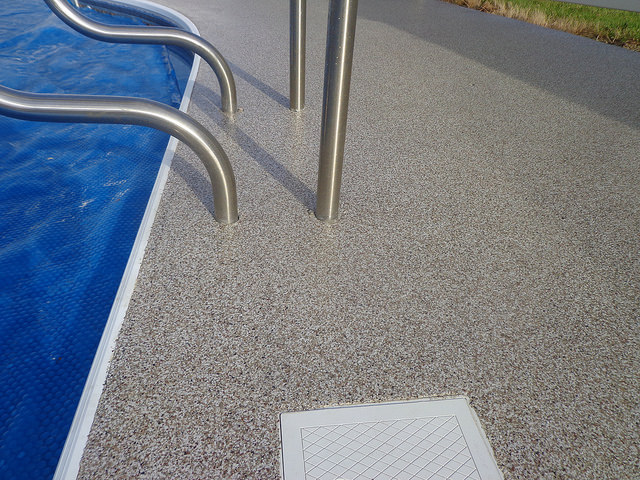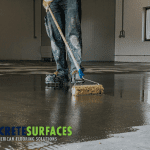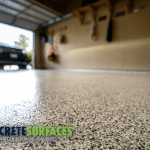Epoxy flooring is one of the best solutions available for people who want a resistant and beautiful option for their spaces. Since epoxy flooring is non-porous, though, it can create slippery conditions with the introduction of water and other substances.
The solution to this problem is to get the right type of epoxy coating plus a great additive. Anti-slip products can help you get the smooth surface everyone loves about epoxy flooring with the bonus of maximum grip. This is especially important in commercial kitchens, or industrial shop floors.
If you want to apply a non-skid additive to your epoxy floor paint, keep reading!
Are All Epoxy Floors Slippery?
Resinous garage floor coatings, such as epoxy, are known for being non-porous. Most of the time, you’ll get a smooth finish in your space. Regardless of the type of epoxy coating you get, you risk having a slippery surface. Not dealing with this problem on time will lead to accidents.
Why Would You Need an Anti-Slip Additive?
You’ll need anti-slip products for your epoxy floor even if you think they’re not necessary. Let’s say you got epoxy for your pool area. When the floor is dry, you will not have any issues with it, as it’ll create enough friction. However, as soon as the water gets into it, it’ll become slippery, causing running children to fall.

Remember this is one scenario out of many. Regardless of where you install your epoxy coat, you risk getting into an accident if the floor gets in contact with water, oil, mud, or other substance.
Anti-slip products will give your floor that extra touch you need without affecting its look. At Canadian Concrete Surfaces, we offer anti-slip textures that help you make the most out of your:
What You Should Know Before Applying a Non-Slip Additive
There are a few questions to ask yourself before applying these textures to your floor. First, you must determine if you truly need them. As mentioned before, if you’re installing the coating somewhere with a lot of water, melting snow, chemicals, or mud, you’ll need anti-slip additives.
Which Option Should You Use?
Now, you must decide which type of additive you want for your project. Many people go for an “aluminum oxide additive,” which is an aggressive texture that gets rid of slippery conditions almost entirely.
The problem with this material is that it can be harsh on the skin, so it’s not recommended for areas where people walk on their bare feet. Moreover, it can make it harder for people to catch dirt or mop strings when cleaning the floor.
A “friendlier” option to use here is “polymer grit,” which you can find in products like Shark Grip. The materials used here are much softer, meaning you won’t have issues with bare feet or skin. If you’re installing epoxy in your patio or pool area, this may be the best option. You should also pay attention to the curing time for epoxy mixed with Non-slip additives.
The last option is silica sand, although not many people like it because of the sand’s visibility. It can be as aggressive as aluminum oxide, and it can also be a little harder to clean.
Other products you could consider include containment mats and carpet runners.
If you have no idea what product to use for your epoxy garage floor coating (or any other space), you can talk to our professionals. They’ll guide you to the best option to achieve maximum slip resistance.
How to Apply It
The method you’ll use to apply a new coat of epoxy texture will depend on which product you got. Let’s go over each method…. one by one.
Method One:
The most common method involves mixing the additive into your final top coat of epoxy. Typically, you would use three or four ounces of product per gallon of epoxy.
Method Two:
If you’re applying your coating to 100% solid epoxy, you must mix the additive into your final coat too. However, you’ll pour the mix in ribbons across the entire space. Once you’re done, you’ll start rolling the mix, which will cause the texture to disperse itself more evenly.
Method Three:
What if you’re adding the additive into a thinner, water-based top coat? You’ll have to mix the additive into your coating and pour the mix into a paint tray. You can start taking the coat and roll it across your floor.
If you go for this method, you have to remix the products every time before pouring them into the tray.
Some people try to sprinkle or toss the additive on top of their flooring’s top coat, and while that could work, you won’t get an even distribution of the product. This can result in surface pockets that will collect dirt.
Out of all the methods we just mentioned, the best one would be the first method mentioned. Also, Polymer grit causes the softest/smoothest feel out of the rest products, and it’s not as visible.
On the other hand, if you’re looking for a solution to industrial flooring, you could consider other products and methods.
Risks of Using Non-Slip Additives
You must be careful when applying your non-slip products to the epoxy flooring. Not following instructions can lead to different health risks, which is why we recommend you seek help from a professional epoxy contractor.
Some additives come with certain chemicals that can cause respiratory issues. Make sure you ask our team before buying any solution for your floor.
On the other hand, you must ensure you’re wearing the right skin and eye protection gear. Not protecting your body can cause the additives to irritate your skin or eyes. As you finish applying the additives, make sure you wash your hands properly.
You can avoid all of those risks by calling a professional, like Devon and his team at Canadian Concrete Surfaces. Once you call us, all you have to do is wait until we’re done, and you’ll get the beautiful and secure floor you’ve always wanted.
Bottom Line
Epoxy flooring and anti-slip products are the best combination to ensure great results in any space. However, you must ensure you’re following all safety precautions to avoid getting a poor result or suffering from any health problems.
Our team at Canadian Concrete Surfaces is committed to helping you make the most out of your epoxy flooring. Even if you’re working with pool or patio concrete, we’ll offer the most appropriate epoxy solution to make your space as safe as ever. Contact us Today for your Free Estimate.

Devon has over 25 years of experience providing customers with high performance epoxy flooring to fit any need or budget. Referrals are our best friend and customer satisfaction is always our top priority. When Devon is not working you can find him fishing, or hunting across North America.







Share This Article
Choose Your Platform: Facebook Twitter Google Plus Linkedin